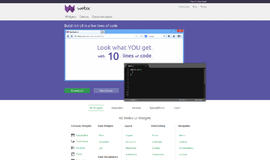ES2018 - New RegEx flag
RegEx. We all know it; it’s perhaps one of the most notorious JavaScript tools out there. But if we limit it to text operations, regular expressions are a very important tool in a developer’s toolbox, for front-end or other JavaScript programmers.
For those of you who don’t know, or perhaps don’t remember, we use RegEx in order to perform various operations on text. An example would be to check if a particular string meets certain conditions that we can set. Say for instance, we want to verify that a certain text contains only letters and not numbers, we can do something like this:
let text = 'someUserName';
/^[A-Za-z]*$/.test(text);// true
text = "' or 68 = '66; DROP ALL TABLES; --';";
/^[A-Za-z]*$/.test(text);// falseIn the example above, I’m using the test method, which is in the regular expression prototype—in other words, every regular expression in JavaScript contains it. It takes a variable and checks if the RegEx is correct. If it is, it receives true, and if not, false. Here for example, I’m checking if a particular string contains only A-Z or a-z. If I get a text string that meets these criteria, I’ll receive true. If not, for example someone is trying to do an SQL injection, I’ll get back false.
For each regular expression there are also flags.
Flags are used for changing the behavior of the RegEx itself. For instance, in the example there is a RegEx that contains A-Z and a-z—in order to have all letters, both capital and lowercase, in the criteria. If I use flag i, I can say that if I use a-z it’s like using A-Z and the opposite as well. In other words, it doesn’t matter if the letters are upper or lowercase—it’s now case-insensitive.
let text = 'someUserName';
/^[A-Z]*$/i.test(text);// true
text = "someUserName";
/^[A-Z]*$/.test(text);// falseIn the first RegEx, I’m using flag i. This means the RegEx A-Z now includes both upper and lowercase letters, it will return true on the text string ‘userName’, which contains both upper and lowercase letters. In the second RegEx I’m not using flag i (notice there is no \i there). So now the same text string will return false because the expression says that only uppercase letters meet the criteria.
There are several useful flags in RegEx, for instance flag m is relevant to text that spans multiple lines. When we talk about multiple line text, for example containing \n, we are entering into what is technically known as “a whole new world of pain.” One of the most well known bugs in JavaScript is that the RegEx for ‘all characters’ doesn’t recognize new line, \n. I’ll demonstrate using this RegEx:
/^.$/
It says, there can be one character, and it doesn’t matter what type. It’s supposed to catch any character: English letters, letters in Hebrew or Arabic. So when does it fail? Only on an empty string:
let text = 'a';
/^.$/.test(text);// true
text = 'ג';
/^.$/.test(text);// true
text = 'ض';
/^.$/.test(text);// true
text = '';
/^.$/.test(text);// false
text = 'cd';
/^.$/.test(text);// false
You can easily see that as long as I’m passing one character, and only one character, the expression works. And if I pass an empty string or more than one character? Bam! We get false.
So what’s the issue then? The problem starts if I check for a new line. Shouldn’t be a problem. New line is considered to be one character. Logic says yes, but if we test it:
text = '\n';
/^.$/.test(text);// falseBefore, there were all kinds of tricks and gimmicks to get around this, which was really too bad. But in ES2018, they’ve added a new flag, flag s, which says the dot (which is what’s supposed to match all characters) will include line terminator characters, like \n. So now:
text = '\n';
/^.$/s.test(text) // trueNotice the \s. So from now on, if you write a RegEx, remember to put in the flag s if you’re using a dot (all characters) and you want to catch line breaks. And if you don’t ever write RegEx? Well hey, at least you learned something new.
About the author: Ran Bar-Zik is an experienced web developer whose personal blog, Internet Israel, features articles and guides on Node.js, MongoDB, Git, SASS, jQuery, HTML 5, MySQL, and more. Translation of the original article by Aaron Raizen.
Recent Stories
Top DiscoverSDK Experts


Compare Products
Select up to three two products to compare by clicking on the compare icon () of each product.
{{compareToolModel.Error}}

















{{CommentsModel.TotalCount}} Comments
Your Comment